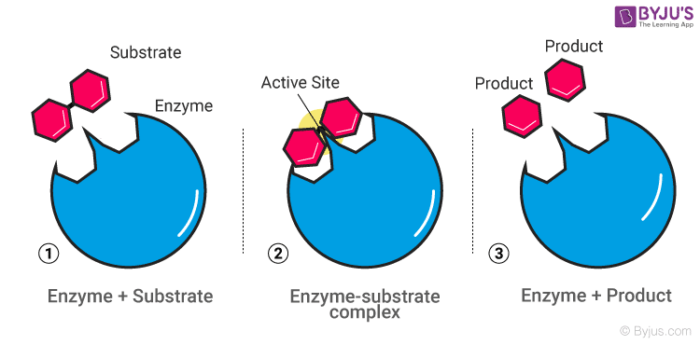
Enzymes are the unsung heroes of the biological world, performing countless tasks that keep living organisms alive and functioning. These remarkable proteins act as catalysts, accelerating chemical reactions within cells, and without them, life as we know it would be impossible. In this comprehensive exploration of enzymes, we will delve into their structure, functions, classification, and the pivotal role they play in biology and industry.
Understanding Enzymes: Nature’s Catalysts
At their core, enzymes are specialized proteins that facilitate chemical reactions by lowering the activation energy required for these reactions to occur. They do so without being consumed in the process, which makes them incredibly efficient and versatile biological molecules.
Enzyme Structure
Enzymes possess a unique three-dimensional structure that enables them to interact with specific molecules known as substrates. This interaction occurs at a region on the enzyme called the active site, which is precisely shaped to fit the substrate(s) involved in the reaction. This specificity ensures that enzymes catalyze only particular reactions, making them highly selective in their functions.
Enzyme-Substrate Interaction
The interaction between enzymes and substrates follows a lock-and-key model. Just as a key fits into a lock, substrates bind to the active site of an enzyme. This binding stabilizes the transition state of the reaction, allowing it to proceed more easily and rapidly.
Enzyme Functions
Enzymes are involved in an astonishing array of biochemical processes within living organisms. Here are some key functions they perform:
1. Metabolic Reactions
Enzymes regulate metabolic pathways, breaking down complex molecules into simpler ones (catabolic reactions) and building complex molecules from simpler ones (anabolic reactions). For instance, enzymes in glycolysis break down glucose into pyruvate, releasing energy.
2. Digestion
Digestive enzymes like amylase, protease, and lipase aid in the breakdown of carbohydrates, proteins, and fats, respectively, during the digestive process, allowing the body to absorb nutrients.
3. DNA Replication and Repair
Enzymes such as DNA polymerases are essential for DNA replication and repair, ensuring the integrity and stability of the genetic material.
4. Cellular Respiration
Enzymes are vital in cellular respiration, a series of reactions that generate ATP (adenosine triphosphate), the cell’s primary energy currency.
5. Immune Response
Enzymes play a role in the immune response, assisting in the destruction of pathogens. For example, lysozyme is an enzyme found in tears and saliva that helps protect against bacterial infections.
Classification of Enzymes
Enzymes are classified into several categories based on their functions and the type of reactions they catalyze. The widely accepted nomenclature for enzymes is established by the International Union of Biochemistry and Molecular Biology (IUBMB). Some common enzyme classes include:
1. Oxidoreductases
These enzymes catalyze oxidation-reduction reactions, transferring electrons between molecules. Examples include dehydrogenases and oxidases.
2. Transferases
Transferases facilitate the transfer of functional groups, such as amino groups or phosphate groups, between molecules. Kinases, which transfer phosphate groups, are a notable example.
3. Hydrolases
Hydrolases catalyze the hydrolysis of chemical bonds by adding water molecules. Lipases and proteases are hydrolases that break down lipids and proteins, respectively.
4. Lyases
Lyases catalyze the addition or removal of groups from double bonds, often without the involvement of water. Decarboxylases are a type of lyase that removes carboxyl groups.
5. Isomerases
Isomerases catalyze the rearrangement of atoms within a molecule to form isomers. For example, glucose phosphate isomerase converts glucose-6-phosphate to fructose-6-phosphate.
6. Ligases
Ligases, also known as synthetases, catalyze the joining of two molecules using energy from ATP. DNA ligase is involved in DNA replication and repair.
Enzymes in Industry and Medicine
Enzymes have far-reaching applications beyond biology. They play a crucial role in various industries, including:
1. Food and Beverage Industry
Enzymes are used to improve food quality, increase shelf life, and enhance flavor. Examples include rennet in cheese production and amylases in baking.
2. Detergent Production
Enzymes are incorporated into laundry and dishwashing detergents to break down stains and organic matter, improving cleaning efficiency.
3. Pharmaceutical Industry
Enzymes are essential in drug manufacturing, including the production of antibiotics and therapeutic proteins.
4. Biotechnology
Enzymes are employed in biotechnology for DNA manipulation, protein production, and genetic engineering.
Conclusion
Enzymes are the unsung heroes of life’s chemistry, facilitating the countless chemical reactions that occur within living organisms. Their remarkable specificity and efficiency make them indispensable for biological processes, and their applications in various industries continue to expand. As we continue to uncover the intricacies of enzyme function and structure, we open the door to a world of possibilities in medicine, biotechnology, and beyond. Enzymes are not just molecules; they are the catalysts that drive the intricate dance of life itself.



